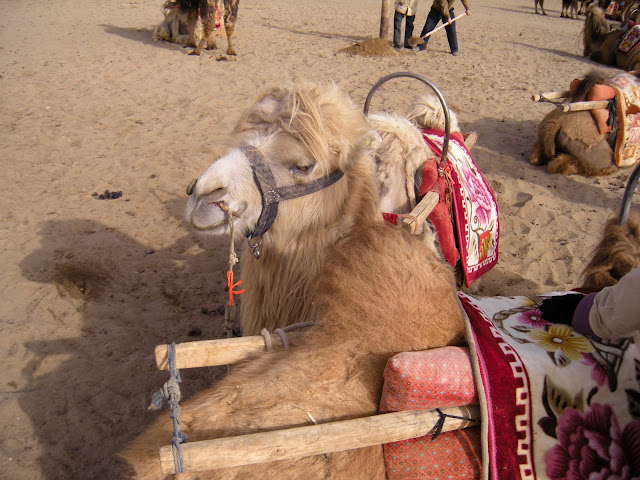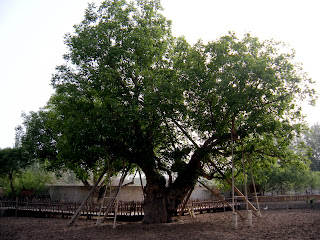Since Dunhuang (敦煌) and Jiayuguan (嘉峪關) were not originally in our agenda, we were still somewhat open to where we spend our time. We knew we had two and half days for the two cities and had to decide on when we should leave Dunhuang for Jiayuguan. Our first thought was to spend our first day and night at Dunhuang, and leave for Jiayuguan the morning of the second day, but Siubo told us we wouldn't get to Jiayuguan until mid afternoon and there were at least three sites he thought was worthy of visiting. Our second choice was to leave Dunhuang by early afternoon on day one, which meant we might not have time for all the sites we hoped to visit. In the end, we ended up picking the latter, let Siubo sleep in while we woke up earlier and took a cab to Mingsha Sand Dunes (鳴沙山) and Cresent Lake (月牙泉).
When we got to Mingsha Sand Dunes, we found the the lines of the sand more elegant. It gave us a different feeling than when we were at Taklamakan Desert. The name "Mingsha shan" translates to "Echoing-Sand Mountain" because it is said that when the wind dances across, it produces flute-like sounds. Legend has it that there was a battle many moons ago, on these sand dunes. During the fight, a fierce wind picked up and buried the generals and their troops. It was after this, that the sand dunes started producing these sounds and the locals thought it must be the troops still fighting under the sand.
Below: Mingsha Sand Dunes
We were given the option to ride a jeep or a camel to go up the sand dunes. As well, you could rent these florescent booties to cover your shoes to prevent sand from creeping in. We opt for the camels as it seemed more authentic. However when we were waiting to get our camels, it seemed like they couldn't understand (or refuse to), put us all in one group. They seem to have groups of 6 camels set up, but somehow split us up. We got these tickets with numbers on them that corresponds to the number on each camel's harness and I guess its too much work for them to re-bundle the camels? Anyhow, on the first ride up, Flora got put in a separate group from us, but that was apparently because I was riding the wrong camel. On the second part of our ride, I was riding with Flora and some other random tourists, while Kel and Annie were in another group.
When we got to our first stop, tourists can pay to rent and drive an ATV around the sand dunes. It looked interesting, but watching others do it, we thought it wasn't as worth it as the ride we took at the Taklamakan Desert. These ATVs didn't seem as fast, and driving ourselves wouldn't be as exhilarating since we wouldn't know how fast and what route is good. Something else they offered there was sliding down the sand dunes with an inflatable doughnut. It looked interesting, but the cost for a ride was pretty high. Plus, you'd have to walk back up after sliding down and anyone who's walked up sand dunes know how tiring that gets. All in all, this stop seemed more like a tourist trap.
The camel station
My pretty camel. :) Doesn't it look like it's smiling?
Left: Kelly taking a picture of me (and yes, that's Annie riding her camel in front of him). Apparently it was so bright that day, that almost all the pictures I was in, I had my eyes closed. :(
Right: Flora on her happy camel.
Left: The prettiest tree ever and in the middle of the sand! Doesn't it look like the magical tree you see in storybooks?
Right: Flora on her camel
Next, we rode our camels to Crescent Lake. It is pretty much what the name is, a pool of water in the shape of a crescent around a pagoda. It was really pretty and we were looking for a story behind such a place since it is in the middle of a desert. However, we found that the pagoda was actually not from back in the day, but rather reconstructed from what they thought it used to look like. We felt somewhat scammed at this point. Also, there wasn't much inside except for a snack stand.
Upon leaving Crescent Lake, we finally got to ride together as a group. The reason being we wanted to go, but the rest of our groups were still inside. Below, you can see us with our camels again. :)
We left Crescent Lake not soon after and went back to meet up with Siubo at the hotel for some lunch. He drove us to the Dunhuang Mogao Grottoes (莫高窟) afterwards. It is said that these rock temples of Dunhuang dated back to 366 AD when a local monk had a vision of a thousand Buddhas in the clouds. The monk then got a rich pilgrim to hire an artist to paint one of the caves and turn it into a shrine dedicated to his well-being during his travels. From then onwards, others would make donations for such shrines to be carved out of the cliff believing this will garner the donor protection. The custom went on for hundreds of years, creating over a thousand of these grottoes. However, because of the remoteness of the Mogao Grottoes, the earliest recorded foreign discovery of the caves was by the Russian explorer, Colonel Prejevalsky, in 1879. One of the key things to note about the Mogao Grottoes, is the hidden library within (what is known today as cave 17). It was discovered by a Taoist priest Wang Yuan-lu in the early twentieth century, whom appointed himself as the guardian of the caves and dedicated himself to its restoration and preservation. Unfortunately, due to his illiteracy, he ended up selling many of these ancient manuscripts to British archeologist, Aurel Stein, and later to French explorer, Paul Pelliot, to raise the funds needed for his project. One of the manuscripts sold to Stein was the Diamond Sutra, the world's earliest printed book dated 868 AD. The scroll is said to be seventeen and a half feet long, ten and a half inches wide, and made of seven strips of paper joined together. It currently resides in the British Museum. Today, only 469 grottoes remain, with paintings, sculptures and inscriptions still somewhat intact.
There were two entrances to the Mogao Grottoes, one for Chinese, and one for foreigners. We did not know this at the time and entered through the Chinese side. The difference between the two was a slightly higher price on the foreigners side, but there they could arrange for non-Mandarin tours. We tried to see if we could pay the price difference and arrange for an English tour, but they would not allow it. They claimed they were different departments/groups and we'd need to pay the full foreigner price again if we were to get the English tour. Blah. We ended up going with random Mandarin groups to see inside the caves since they lock them up and only the guides would have the key. We also piggybacked off of another English guide as they were finishing their tour. Due to preservation reasons, cameras were not allowed inside past the admission gates. But we did find it quite interesting as these grottoes were very well preserved. The caves would have colourful wall murals, alongside buddhas of various sizes. We learnt much about the excavations by the Swedes, Germans, Brits, Japanese, and later the Americans in the early twentieth century. Below, I've found some pictures from various sites online so you'd get a feel as to what we saw.
 |
| via www.the-silk-road.org |
 |
| via buddhistchannel.tv |
 |
| In this tower, we found a gigantic buddha made of clay 35.5m high. |
 |
| via relax.com.sg |
We left Dunhuang by late afternoon, and headed towards Jiayuguan travelling another 448 kilometers for over seven hours before resting for the night.


































































